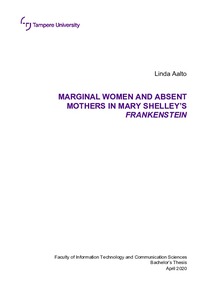Marginal Women and Absent Mothers in Mary Shelley's Frankenstein
Aalto, Linda (2020)
Aalto, Linda
2020
Kielten kandidaattiohjelma - Bachelor's Programme in Languages
Informaatioteknologian ja viestinnän tiedekunta - Faculty of Information Technology and Communication Sciences
This publication is copyrighted. You may download, display and print it for Your own personal use. Commercial use is prohibited.
Hyväksymispäivämäärä
2020-04-30
Julkaisun pysyvä osoite on
https://urn.fi/URN:NBN:fi:tuni-202004243677
https://urn.fi/URN:NBN:fi:tuni-202004243677
Tiivistelmä
This thesis examines social criticism in Mary Shelley’s Frankenstein. The novel subtly challenges the constructions of the patriarchal society and simultaneously demonstrates the hardships women faced in this male-centered world. In analyzing Frankenstein the focus is on two prominent themes: the marginal women and the absent mothers. The aim of this thesis is to identify the aspects of the society that are being criticized and to illuminate the ways in which this criticism is expressed.
Elaine Showalter’s gynocritical theory along with some earlier feminist studies of the novel offer the theoretical framework for the analysis. In the theory section of the thesis, the focus is on describing the clandestine forms of communication that women had to develop in order to be able to discuss their feminine experiences and emotions in their literature as their self-expression was limited by a double standard. These include imitating the male way of writing, publishing anonymously and using symbolic elements and images that are connected with female sexuality and motherhood.
Three major aspects of the society that are being criticized are identified. These are the marginalization of women, women’s exclusion from the public sphere of life and the dysfunctionality of the egoistic, patriarchal society. In Frankenstein, the all-male society is lacking feminine sentiment and is thus covertly portrayed as corrupted. In addition, two central themes, connected to these criticized aspects of society, are recognized: the patriarchal fear of womanhood and the conflict between the feminine ideal of self-sacrifice and patriarchal egotism. The most central finding in this thesis is that by reversing the traditional gender stereotypes, Frankenstein reveals the corruption of the patriarchal society and thus highlights this society’s need for feminine and motherly sentiment.
Elaine Showalter’s gynocritical theory along with some earlier feminist studies of the novel offer the theoretical framework for the analysis. In the theory section of the thesis, the focus is on describing the clandestine forms of communication that women had to develop in order to be able to discuss their feminine experiences and emotions in their literature as their self-expression was limited by a double standard. These include imitating the male way of writing, publishing anonymously and using symbolic elements and images that are connected with female sexuality and motherhood.
Three major aspects of the society that are being criticized are identified. These are the marginalization of women, women’s exclusion from the public sphere of life and the dysfunctionality of the egoistic, patriarchal society. In Frankenstein, the all-male society is lacking feminine sentiment and is thus covertly portrayed as corrupted. In addition, two central themes, connected to these criticized aspects of society, are recognized: the patriarchal fear of womanhood and the conflict between the feminine ideal of self-sacrifice and patriarchal egotism. The most central finding in this thesis is that by reversing the traditional gender stereotypes, Frankenstein reveals the corruption of the patriarchal society and thus highlights this society’s need for feminine and motherly sentiment.
Kokoelmat
- Kandidaatintutkielmat [7045]
